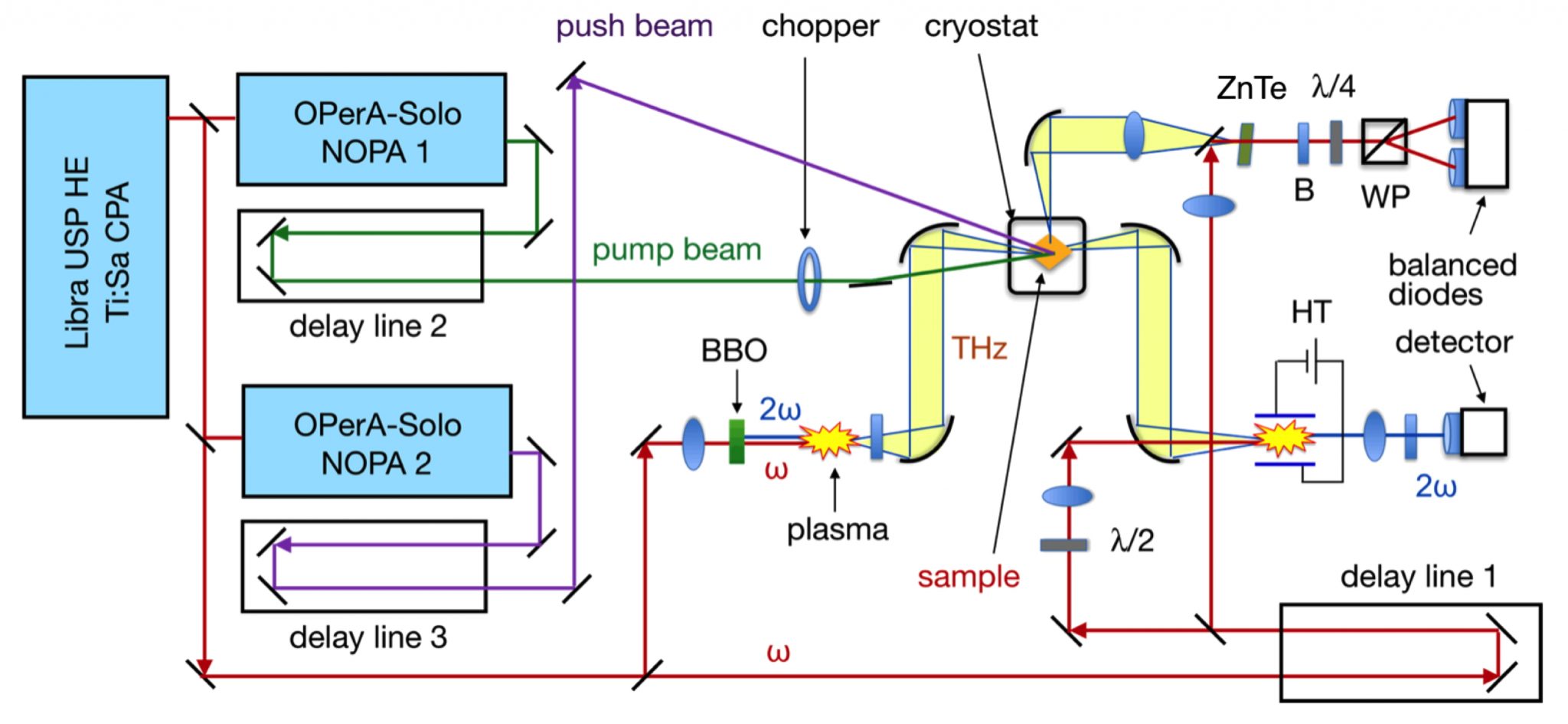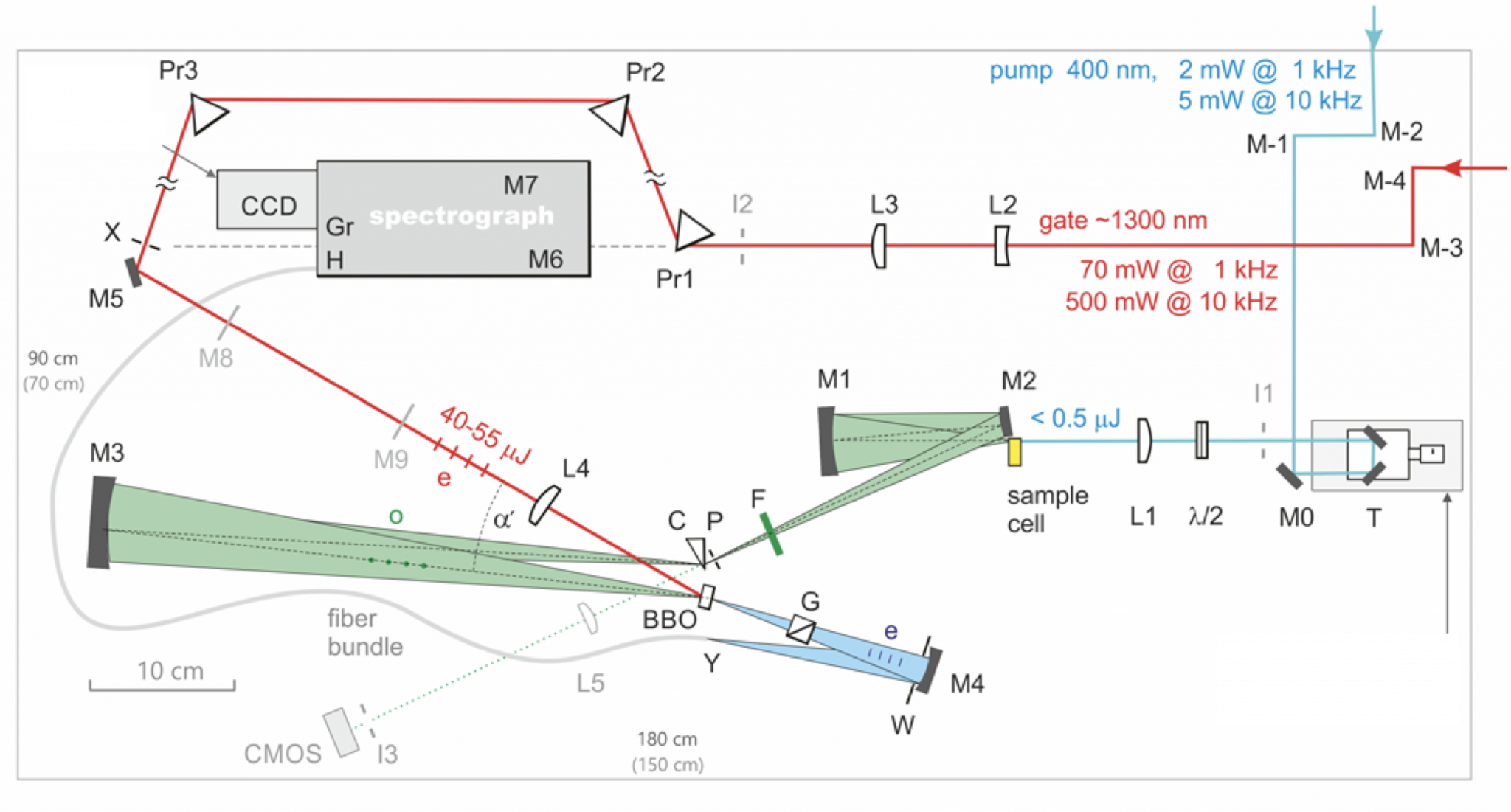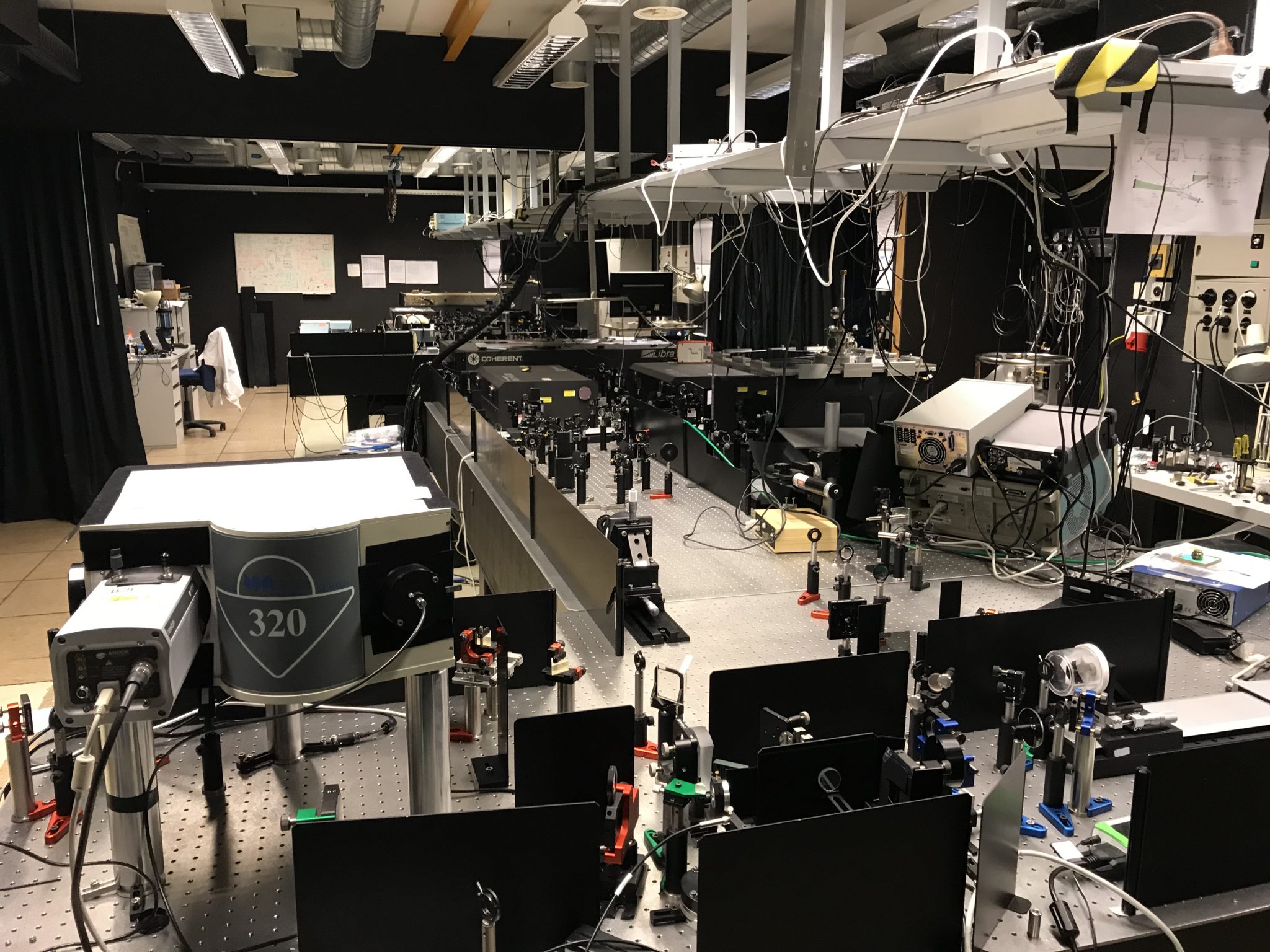d
Ultrafast Laser Spectroscopy
a
Femtosecond Pump-Probe Absorption/ Reflectance Spectroscopy
In a typical transient absorption spectroscopy experiment, a fraction of a sample molecules or material is promoted to an electronically excited state by means of an excitation (or pump) laser pulse. The pump pulse is generated by a chirped pulse amplified Ti:Sa femstosecond laser (778 nm, 120 fs pulse duration, 1 kHz repetition rate). The wavelength is then tuned in a dual-stage non-collinear optical parametric amplifier (NOPA) and the pulse compressed down to a duration of < 50 fs by a SF2 prism pair. A white light continuum probe pulse generated in an oscillating CaF2 plate is sent through the sample with a time delay τ with respect to the pump. A difference absorption spectrum is then calculated. By changing the time delay τ between the pump and the probe and recording a ΔA spectrum at each time delay, a ΔA profile as a function of τ and wavelength λ, i.e., a ΔA (λ,τ) is obtained. ΔA (λ,τ) contains information on the dynamic processes that occur in the system under study, Conversely, a sub-50 fs duration probe pulse can be produced in a second NOPA. This dual color configuration affords a cross-corelation time at the sample position of typically 70 fs.
Phys. Chem. Chem. Phys. 2021, 23, 23886-23895
sjhdg

jdha
Ultrafast time-resolved diffuse reflectance spectroscopy is a technique for analyzing photophysical and photochemical dynamics of light scattering materials such as powders and opaque electrodes. Using parabolic or ellipsoidal mirrors to focus the probe beam to a sample and collect diffusely reflected light allows to reach a sub-ps time resolution and a spectral chirp that can be rather easily corrected.
E. Ghadiri, Thesis no. 6307 (EPFL, 2014)
Sci. Rep. 2016, 6, 24465
Rev. Sci. Instr. 1998, 69, 361
s
Time-Resolved Electroabsorption Spectroscopy (TREAS)
TREAS, also called electromodulated ultrafast differential absorption/ reflectance (EDA), is a method designed to optically probe electric field-induced changes of transient absorption (Stark and Franz–Keldysh–Aspnes effects). A modulated electric field of 104 – 106 V cm–1 is applied to a film sample placed between an insulated metal electrode and an insulated conductive glass window. This field results in a quadratic Stark effect that is probed optically in a transient reflectance spectrometer. Carriers photoproduced by the pump pulse generate a local electric field that opposes to the externally applied field. The light-induced transient change of the Stark signal and the recording of its time-evolution allow for measuring carrier and quasiparticle dynamics and mobility on a wide range of distances and is complementary to time-resolved THz spectroscopy.
J. Risse-De Jonghe, Thesis no. 6627 (EPFL, 2015)
J. Phys. Chem. C 2016, 120, 19595-19602
Nat. Commun. 2016, 7, 12556
Proc. SPIE 2015, 9549, 95490J 1-6
J. Am. Chem. Soc. 2015, 137, 8192-8198
In the absence of an externally applied electric field, light-induced changes of permanent dipoles or of the polarizability in a system can induce an electric field perturbation to the surrounding materials. This perturbation is at the origin of a photoinduced electrobsorption (Stark effect), whose spectro-temporal evolution is exploited to probe charge separation dynamics. Light absorption by charge-transfer (CT) excitons, occurring from the Coulomb interactions of an electron and a hole separated by an interface, for instance, are characterized by a change in the permanent dipole moment and, hence, induce an electric field perturbation that can be probed optically with femtosecond time-resolution..
M. E. F. Bouduban, Thesis no. 9668 (EPFL, 2019)
Chem. Sci. 2017, 8, 4371-4380
Chimia 2017, 71, 231-235
a
Ultra-Broadband Time-Resolved Terahertz Spectroscopy
TRTS is a method used to study the dynamic properties of materials at THz frequencies (far-IR). In the optical pump-THz probe scheme (OPTP), it uses a fs pulse in the visible to excite a sample, and then measures the changes in an ultra-broadband probe THz pulse transmitted or reflected by the sample as a function of time. The technique is useful for characterizing a wide range of materials, including semiconductors, polymers, biomolecules, solvents, ice and more. It can provide in particular vibrational spectra and dynamics in molecules, as well as charge carrier and quasi-particle mobility and dynamics in semiconductors.
An important class of THz sources relies on the frequency conversion of femtosecond lasers to deliver coherent single cycle pulses, enabling time-domain THz spectroscopy with the unique ability to characterize the complex electric field of a THz pulse to yield full phase and amplitude information, an advantage over other techniques where only intensity is measured. A special mention among the THz sources used in our labs is deserved by the ultra-broadband THz generation and detection by laser-ionized plasma. This scheme provides a much broader bandwidth with respect to all other sources introduced so far, extending above 20 THz and thus yielding a time-resolution < 150 fs.
A. Burgos Caminal, Thesis no. 7891 (EPFL, 2020)
J. Phys. Chem. C 2021,125, 98-106
J. Phys. Chem. Lett. 2020, 11, 7692-7701
J. Phys. Chem. C 2015, 119, 26266-26274
wef

a
Braodband Fluorescence Up-Conversion Spectroscopy
Time-resolved emission bands can be observed by simultaneous sum-frequency mixing with femtosecond near-infrared gate pulses over a wide frequency range. Using tilted gate pulses in a non-collinear geometry we achieve 80 fs time resolution and background-free measurement of upconverted spectra. All components were optimized resulting in a spectrometer without any moving part.
E. C. Socie, Thesis no. 9826 (EPFL, 2022)
Adv. Optical Mater. 2021, 9, 2001308 (1-6)
J. Phys. Chem. Lett. 2020, 11, 387-394
http://www.liop-tec.com/resources/FLUPS_Flyer_20170419.pdf

skjd
Nanosecond Laser Flash Photolysis
An optical parametric oscillator (OPO) is pumped by a frequency-tripled Q-switched Nd:YAG laser (λ = 355 nm; 20 Hz repetition rate, 3 W average power). The output of the OPO is tuned at the desired wavelength to excite the sample. The absorption change of the sample is probed in a single beam spectrophotometer scheme: The light generated by a cw xenon arc lamp, filtered through a monochromator and various filters, is focused onto the sample at 90° to the excitation beam and then collected through a second monochromator. A fast photomultiplier tube or an amplified photodiode are used to measure the probe light’s intensity in real time. A large bandwidth digital oscilloscope then records the temporal evolution of the induced transient electrical signal. The time resolution of the instrument is limited by the excitation laser pulse (5 ns full width at half-maximum). The sensitivity of the measure obtained by averaging the signal over 1000-3000 laser shots is typically ∆A < 10–4.
J. Phys. Chem. C 2014, 118, 17108-17115
sd

scd
Diffuse reflectance laser flash photolysis
Samples in the form of liquid solutions contained in a square section quartz cell or in the form of thin films deposited on a glass support are generally sufficiently transparent for the prbe beam to pass through them. Analysis of the intensity of the light reaching the detector then yields the absorbance change ∆A.Transmission spectrometry is not applicable, however, to opaque samples (films deposited on a metal electrode, highly scattering materials, powders, etc.). In this case, diffuse reflectance spectrometry (DRS) has to be used.
A DRS accessory based on Harrick’s “Praying Mantis” design has been built in our lab to replace the usual sample holder without any need to modify the rest of the optical geometry. This accessory is constituted of two 6:1 90° off-axis ellipsoidal mirrors. The first one focuses the probe light onto the surface of the sample, while the second collects about 20% of the total light diffusely reflected at all angles between 0° and 90° and directs it towards the monochromator and the detector.
J. Phys. Chem. C, 2023, 127, 23285-23295

